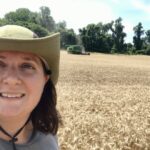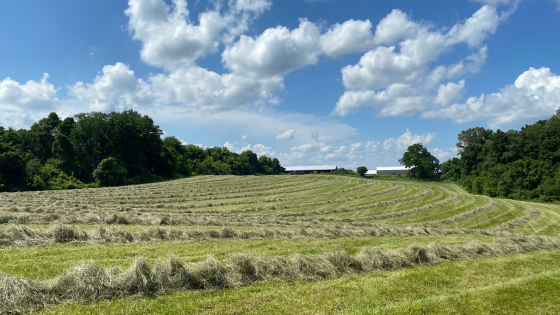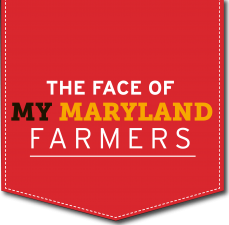 If you’ve ever been on a “hay ride,” you may be surprised to learn that the seating is made of straw, not hay. Many people have a hard time telling these two farm staples apart, but they are quite different. Hay and straw play very distinct roles in farming and agriculture, and they offer unique benefits when it comes to animal feed, bedding and more.
If you’ve ever been on a “hay ride,” you may be surprised to learn that the seating is made of straw, not hay. Many people have a hard time telling these two farm staples apart, but they are quite different. Hay and straw play very distinct roles in farming and agriculture, and they offer unique benefits when it comes to animal feed, bedding and more.
At Griffith Family Farm in Lothian, they have both. “On our farm, we grow orchard and fescue grasses for hay, while straw is one of the products that we make from our wheat crop,” says Kayla Griffith who farms with her father, Jeff. “We’ve had hay and straw on our farm for generations. When my great grandfather was alive, he had cattle and we used the straw for bedding and hay for feed.”
The biggest difference between hay and straw is in their composition. Hay is made up of grasses and legumes that have been cut, dried and baled. This means that it retains many of the nutrients that the original plants had. “Hay differs from straw in that it is a green, actively growing grass made up of the stem, leaves and sometimes seed head of the plant. Hay may look like someone forgot to mow their lawn for many weeks, but making hay is much more complicated than straw,” Kayla says.
In Maryland, she adds that you can often make three “cuttings” of hay, meaning that farmers cut and bale hay off of the same field three times per year. “Hay is cut on our farm by a mower conditioner attached to a tractor. Once cut, the hay has to sit untouched for one day. After that, we use a machine called a tedder to spread the hay evenly over the field. This allows the hay to dry completely before we rake it back into rows and bale it,” she adds. Since it is green when cut, if hay is not allowed to properly dry before harvest, it can actually catch on fire.
On the other hand, straw is made from the stems and stalks of crops like wheat, barley, rye and others. Because of this, it is much less nutritious than hay and lacks the characteristic leafiness of hay. This makes straw better for bedding and less ideal for animal feed. “In the fall we plant soft red winter wheat, which grows all winter. We harvest the wheat in early July with a combine. You know wheat is ready to harvest when the field is brown and dry, which is a main way to identify a field of wheat from a field of hay as you drive around in the middle of summer,” Kayla says.
Then, she explains that the combine removes the wheat berries, the part of the wheat that gets ground up into flour, from the rest of the plant. The wheat berries go into a truck and then to a grain elevator. The combine puts the rest of the plant, essentially just the stalk of the wheat, on the ground. “We go behind the combine and bale the straw into small square bales. Those bales are mostly used for livestock bedding, but sometimes they are used for erosion control on construction sites,” Kayla adds.
Hay is generally used as feed for livestock or animals on farms. Because it is full of nutrients, it is a great option for cows, horses and other animals that need a lot of energy. It helps animals stay healthy and provides them with vital nutrients they need to thrive.
“On our farm, we bale hay into small square bales and round bales that we use as livestock feed. We sell our hay to other farmers, too, where it is eaten by a variety of animals including horses, cattle, goats, sheep, alpacas and even camels,” she says.
Another key difference between hay and straw comes in how they are stored. Because hay is rich in nutrients, it requires careful storage to ensure that it doesn’t rot or spoil. It must be kept in a dry, dark space to maintain its quality. Straw doesn’t need quite as much care because it doesn’t lose much of its quality over time. “It’s wet enough in Maryland that if stored outside without proper cover, the straw can reseed or the string becomes compromised. So on our farm, we store our straw in our old tobacco barns,” Kayla says.
Next time you have a chance to take a “hay ride,” you can share with your friends your newfound hay vs. straw knowledge.
Hungry for more? Read about a conservation-forward farm that grows hay. Learn about Miscanthus grass grown for chicken bedding.
Sign up for our newsletter and find us on Facebook, Twitter and Instagram.

